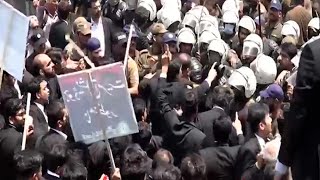Telecom sector's contribution to exchequer nosedives

Telecom sector contribution to the national exchequer and the Foreign Direct Investment (FDI) in the sector are on a continuous decline, remaining Rs95 billion and $635.3 million, while registering 37 percent and 20 percent fall, respectively during 2018-19.
This has been revealed in the annual report 2019 of Pakistan Telecommunication Authority (PTA) released Friday.
Telecom sector contribution to the exchequer is on a continuous decline, remaining at Rs95 billion during 2018-19 compared to Rs143.23 billion in 2017-18, a decline of over Rs48.23 billion, ie, 37 percent.
Telecom contribution to the exchequer stood at Rs243.88 billion in 2013-14, Rs126.26 billion in 2014-15, Rs160.17 billion in 2015-16, Rs161.43 billion in 2016-17, Rs147.23 billion in 2017-18, which further declined to Rs95 billion in 2018-19, revealed the PTA.
The telecom sector contributed around Rs95 billion to the national exchequer in the form of general sales tax (GST), duties, levies and PTA deposits including license fees, spectrum fees in addition to levies by the local governments and custom duties by the Federal Board of Revenue (FBR).
This shows a 37 percent decrease in the contribution owing to the suspension of taxes on telecom services by the Supreme Court of Pakistan for the period of 10 months (13 June, 2018 to 24 April, 2019), maintained by the PTA.
Telecom investment stood at $635.3 million during 2018-19 compared to $792.6 million in 2017-18, registering a decrease of $157.3 million. Telecom investment stood $1.815 billion in 2013-14, $1.005 billion in 2014-15, $719 million in 2015-16, $971.7 million in 2016-17, $792.6 million in 2017-18, and $635 million in 2018-19, it added.
The country attracted $406.1 million investment from cellular mobile companies in 2018-19, against $568.1 million during the same period of previous year, registering a decrease of $160.1 million.
Long Distance International (LDI) attracted investment of $18.2 million in 2018-19 compared to $24.6 million in 2017-18, and fixed line $210.9 million in 2018-19 compared to $199.9 million during the same period of last year.
The PTA also generated $1.3 billion through license renewal fee, of which 50 percent has already been deposited in national coffers.
Three cellular mobile licensees Telenor Pakistan, China Mobile Pakistan (CMPak) and Pakistan Mobile Company Limited (PMCL) were due for renewal in 2019.
License renewal is under process with enhanced terms and conditions in line with Pakistan's and the industry's long-term interests.
Telecom sector revenues grew by 12.9 percent and total revenues stood at Rs552 billion in 2018-19.
The main contributor to revenue remained the mobile sector with total revenues crossing Rs444 billion, followed by Fixed Local Loop (FLL) and Wireless Local Loop (WLL) services at Rs69 billion.
Two major operators with foreign ownership have declared huge profits at the group level internationally from their operations in Pakistan.
Mobile sector showed a steady growth in subscribers on its networks and increased subscriber base to 163.5 million at the end of 2018-19, showing a year-on-year growth of seven percent.
Total teledensity is 77.7 percent where the main contribution is by the mobile sector with penetration crossing 76.4 percent.
Local manufacturing has kick-started and Pakistan produced over 11.7 million handsets in 2019.
Commercially imported legal handsets for the same period stood at 16.3 million.
Rapid growth in mobile data traffic and consumer demand for an enhanced mobile broadband experience has led the regulator to the introduction of the fifth generation of mobile technology (5G).
The PTA has initiated work on it and 5G tests and trials have already started. The PTA has also initiated the process of spectrum re-farming in collaboration with the Frequency Allocation Board (FAB) for efficient spectrum utilization.
The process of formulation of an Administrative Incentive Pricing (AIP) framework for the microwave spectrum for new and existing assignments is also underway.
A regulatory framework for Over-the-Top (OTT) services in Pakistan is being developed in-house with the objective of managing the OTT services smoothly in Pakistan.
The PTA has also established a framework for a Computer Emergency Response Team (CERT) for the telecom sector.
The PTA has successfully launched the DIRBS in the reported year and very encouraging results have been witnessed in terms of evaporating grey market, substantial decrease in illegal/counterfeit devices, and significant drop in snatching/theft of devices and increased.






















Comments
Comments are closed.